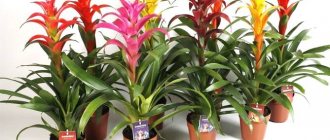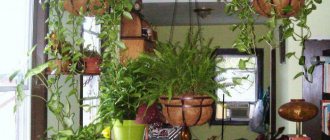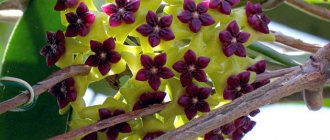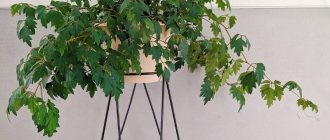Climbing indoor vines are very popular among gardeners. Wax ivy is one of these plants, but the bad omens associated with it force many to give up growing the flower at home. Some people think that Hoya brings only bad luck, although there are many good things about it. Before making hasty conclusions about a luxurious liana, you need to learn more about its influence on different areas of the life of its owners.
What does the flower symbolize?
Hoya is an evergreen liana-like shrub from the Kutrovaceae family. Its natural habitat is the tropical forests of East Asia. To those who look at hoya, it seems that it is artificial. The dark green leaves have a rough texture and the flowers appear to be cast from wax. Thin shoots of vines at home grow up to 5 meters in length. A beautiful plant attracts the eye and delights people.
Do not confuse hoya fleshy, which is often called wax ivy, with common ivy (hedera). These are completely different plants belonging to different families, although they have some similarities.
Hoya is an evergreen plant, so it symbolizes youth and immortality. She is associated with such qualities as coquetry and curiosity. She is often compared to a young girl who, due to her young age, continues to behave childishly. According to signs and superstitions, growing indoor ivy at home can bring invaluable benefits to its owners, but some believe that it can harm household members.
https://youtu.be/https://www.youtube.com/watch?v=sb2WSvJW6lQ
_
What energy does this plant carry?
Believe it or not, this “mini-liana” is a real energy vampire, fueled by the “life flows” of the owners of the house. But at the same time, bindweed can give people a sense of self-confidence (not narcissism or selfishness, but self-confidence).
Find out what awaits you today - Horoscope for today for all zodiac signs
Due to numerous requests from subscribers, we have prepared an accurate horoscope application for mobile phones. Forecasts will arrive for your zodiac sign every morning - it's impossible to miss! Download for free: Daily Horoscope 2020 (available on Android)
Esotericists advise: keeping indoor ivy is worth it in families where emotions are constantly seething. The plant will smooth out the pranks of a hyperactive child, the frantic rhythm of an overly emotional person (for example, a purebred choleric), the passions of “Italian love” in a couple. Green leaves will absorb all excess emotions - especially negative experiences “to their liking”.
Magical properties of vines
According to folk superstitions, the ivy flower has very powerful energy. Here are the magical properties attributed to this plant:
- According to legend, ivy is fueled by the energy of the residents of the house. However, there is nothing wrong with this - the flower does not destroy people’s biofield and does not take away their vitality. It absorbs only bad energy, thereby purifying the space.
- It's a good sign when ivy grows in the yard. In this case, household members do not need to be afraid that a sorcerer or witch will enter the house. According to legend, the flower will protect the family from the evil eye and damage.
- It is useful for young unmarried girls to carry a leaf of wax ivy in their pocket. According to the sign, he will help you meet a worthy guy who may well become a husband.
- Those who are in a difficult life situation and cannot decide what to do best should weave an ivy wreath and put it on their head for a while. The symbolic crown will help you think clearly and rationally.
- According to legend, you can entwine a house with ivy so that it protects the family from magical influences from the outside and misfortunes.
street obstruction
Perhaps it is not for nothing that ivy is used as an outdoor plant to decorate the walls of entrances and facades of houses. When a flower is outside the house, it can serve as a protective element against evil impulses. A person who wants to enter a house with bad thoughts simply will not be able to carry out his plan if there is ivy hanging in front of the entrance. The plant is quite sensitive to the dark outlines of the aura and easily reads them, acting as an exposer of evil.
When indoor ivy climbs along the wall of a country house, it will protect it from natural disasters, the evil eye and the envious glances of neighbors. From this we can conclude that indoor ivy and signs about it are associated with the plant being in a confined space. You can take these observations into account and not give up growing indoor ivy.
How people treated ivy in the old days
Our ancestors were kind to wax ivy. He was credited with the ability to heal people. According to legend, a person who fell ill with whooping cough needed to drink a tincture of fleshy hoya in order to recover faster. They just took the medicine from a wooden spoon.
Read also: What does a meeting with a woodpecker entail according to signs?
In ancient times, ivy was also used to treat various eye diseases. Those who believed in omens about this flower placed its leaf in a bowl of water for a day. The next day, the eyelids were washed with healing liquid. Previously, it was believed that even blindness could be cured in this way.
Ivy was also used in fortune telling. On the first Sunday after the celebration of the Trinity, the young men plucked 10 leaves from the plant, then put 9 under their pillow before going to bed, and threw away the last one. According to legend, the young man was supposed to dream about his future wife. If the guy already had a fiancée at that time, then with the help of this fortune-telling it was determined whether she would be the only woman, or whether another would appear in the young man’s life.
Is ivy poisonous
Ivy does not apply. It does not contain any substances harmful to human health. It also does not emit any dangerous chemicals, so it can be kept indoors.
The idea that hibiscus is considered unsuitable for indoor use is largely a fiction.
. Therefore, for those who do not believe in omens, ivy can become an excellent decorative element that will green and decorate any room.
Each indoor plant has a certain energy. Many of them are characterized by the ambiguity of their impact. Signs about whether it is possible to keep indoor ivy at home are also contradictory. They will talk about the influence of culture on a person’s mental and physical state. The plant can also determine the course of events.
Bad Omens
Although hoya is a fairly popular houseplant, some are wary of it. The reason lies in superstitions that attribute negative properties to the flower. Wax ivy is called an energy vampire. If you believe the signs, his stay in the apartment can have a bad effect on the household. Vyun is often accused of causing quarrels and scandals at home. However, those who love this plant and have been growing it for many years do not notice anything like this.
According to superstition, ivy should not be used for landscaping walls in the bedroom of a baby or an elderly person. Such people have weak energy, and a vampire flower can undermine their health.
The ivy plant is associated with a sign concerning women. According to legend, married people should not bring an overgrown vine into the house, as it will destroy family ties. As a result, the husband will begin to cheat on his wife or go to live with another.
Indoor ivy - negative signs
Ivy (chedera)
It would seem that the plant fills the room with positive energy, attracts all the good things, and it is a must to have one at home. However, many believe that ivy has a scary feature.
It consists of energy vampirism. It is worth making a clarification - initially the plant absorbs negative energy, and if it does not get enough, it is mistaken for positive energy. Therefore, it is best to keep ivy on the balcony, in the home front garden. As soon as you feel that the atmosphere is heating up, a scandal begins, bring it into the room. Let the plant absorb all the bad things, then take it back.
If all the walls in the house are covered with climbing ivy, a single girl will not marry, since the plant will repel the opposite sex from her.
It was said above that for a married woman, blooming ivy is a good omen, but according to another superstition, it will, on the contrary, drive her husband out of the house.
A vine that has fallen off a large and strong plant foreshadows collapse and large financial losses. Melancholy people who grow such a flower will become even more vulnerable.
Does the flower bring misfortune?
Some beliefs about this plant are so scary that many people give up the idea of growing it at home. For example, one of the signs says that hoya can kill a person with its aroma. However, this information has not been scientifically confirmed. The stems, leaves and petals of the vine do not contain toxic substances.
Only those people who have been diagnosed with asthma need to be careful. If allergens enter the respiratory tract, they can cause swelling of the mucous membranes and an attack of suffocation.
Ivy is an ancient plant
Superstitions about ivy date back to ancient times. Ivy was very popular and helped people treat a variety of diseases. Cups made from ivy had healing properties. It was enough for a person to drink medicine from such a container, and he immediately recovered. The leaves of the flower were brewed, and then the eyes were rubbed with the decoction. This method was successful even among the blind.
Young guys used ivy to tell fortunes for their betrothed. They hid nine flower leaves under the pillow, threw out the tenth, and in a dream they could see their future wife. If a man already has a girlfriend, then in a dream he could see whether they will have a wedding or not.
The benefits and harms of hoya for humans
Wax ivy, or hoya, to which signs and superstitions attribute magical properties, has many beneficial properties. The leaves of the plant purify the air well and release a lot of oxygen. Thanks to this, brain activity improves and performance increases. Hoya reduces the harmful effects of electromagnetic radiation emanating from household appliances. In addition, ivy secretes phytoncides that prevent the development of pathogenic microflora.
This flower is recommended to be kept at home for those who suffer from furunculosis or carbunculosis. Ivy contains substances that inhibit staphylococcus bacteria. Chiryak will ripen and open faster if you apply plant leaves to it at night.
In some cases, ivy can cause harm to humans. People with allergies should not grow it at home. During flowering, pollen enters the air, which can trigger the development of an allergic reaction. The juice from the leaves causes skin irritation in some people, so it is better to care for the flower with gloves.
Read also Folk signs about spring
Popular types of home ivy
- Colchis is a liana with fairly large whole or three-lobed leaves, 15-18 cm wide, up to a quarter of a meter long. The leaves are oval or three-lobed with a characteristic musky aroma. The aerial roots of the vine give it the ability to stay on a support and climb to a height of up to 25-30 m. It blooms with small flowers with a specific smell, collected in inflorescences in the form of an umbrella.
- Canary - it is also called Algerian. A fast-growing vine with large leaves in a variety of colors: from solid green to feathery yellow or white-green. It does not have aerial roots, so it needs support. The plant requires intense light and high humidity, but will tolerate light shading. Ivy needs pruning, otherwise it takes on a sloppy appearance.
- Ordinary - the colors of the 3-5-lobed leaves are varied: from solid dark and light green to pinnate with a white or yellow pattern, they may have an edge. It blooms with small greenish-yellow flowers collected in an umbrella. Berries up to 1 cm in size, poisonous.
- Pastukhova - the vine has aerial roots, with the help of which it entwines vertical supports. The leaves are leathery, bright green, 6 cm wide, 10 cm long, of various shapes: lanceolate, rhombic, ovate, mixed. It blooms with inflorescences in the form of sparse spherical umbrellas. The inflorescence contains from 5 to 20 flowers. In place of the inflorescences, fruits are formed - berries up to 1 cm in diameter, black with a purple tint, very poisonous.
Among the huge variety of types and varieties of ivy, it is not difficult to choose a plant to suit your taste, which will decorate your home and will delight you for many years.
In ancient times, people often showed their powers of observation, noticing various signs, noticing coincidences, etc. All this formed the basis of numerous superstitions that are still used in the modern world. Indoor plants, including ivy, were not spared either. There are a large number of legends associated with it, which many people believe in. This plant is considered the most common and popular, since with the help of beautiful, climbing vines you can decorate not only your garden plot, but also any interior.
Signs about indoor ivy
People believe that plants are living, therefore they contain a certain energy that affects a person to a greater or lesser extent. The ivy houseplant is an energy vampire that lives on human energy. Although one can find a radically different opinion, according to which the flower itself has high potential and supplies its owners with confidence
In general, ivy can be classified as a useful indoor plant, since it takes away negative energy from a person, which in some cases is very important
A flower such as indoor ivy would be appropriate in the home of people who are often overwhelmed with various emotions and do not know where to spend their excess energy. Parents with hyperactive children should consider it. The plant will act like a sedative.
Other signs about the ivy indoor plant:
- It is not recommended for single women to get him, as he will do everything possible to repel all men. Ivy is often called "husband".
- Ivy is a symbol of resilience and vitality, so it is recommended to be placed in office spaces.
- The plant helps to process foreign energy that enters the house from the outside. In this case, ivy can be used as a cleanser.
Indoor ivy, or Hedera, is one of the most popular plants among amateur gardeners, belonging to the genus Ivy (Hedera) and the Araliaceae family. This evergreen and climbing ornamental shrub includes several well-proven varieties at home, which differ in the shape and size of the leaves, flowering and the length of the aerial parts.
Is it possible or not to keep ivy at home?
According to florists, wax ivy can be kept at home, and the signs associated with it, in most cases, have a positive interpretation. It is believed that this flower protects the home from evil. It’s not for nothing that our ancestors planted loaches near the house. They believed that in this way they could protect the family from uninvited guests, from people associated with black magic.
There are different opinions about this flower. Some are afraid to keep a loach at home because it supposedly feeds on human energy and destroys family ties. Other people are happy to grow overseas liana, considering it not only a wonderful decoration for their apartment, but also a protector from evil. Before you get a hoya, you need to find out what is really hidden under its external beauty.
Positive signs
Having studied the signs about wax ivy, it becomes obvious that it can become a real amulet for a family and bring invaluable benefits to its owners. According to popular belief, the liana helps to find harmony in relationships between spouses, prolong youth and achieve success in professional activities.
Common interpretations of good signs about hoya:
- a plant that is well cared for at home promotes peace in the family;
- According to legend, this flower calms easily excitable people, for example, rude, aggressive men, irritable women, rebellious teenagers;
- a married couple who grows a long vine from a tender shoot will live a long and happy life;
- Caring for a young plant will help single girls find love;
- For those who carry a hoya leaf in their breast pocket, the sign prophesies eternal youth and good health.
If you trust signs, the ivy flower gives confidence to pessimists. This plant is also useful for melancholy people. It will help you discover your good qualities and increase your self-esteem.
Negative signs
Those who want to grow this perennial at home need to learn more about it. Some ancient beliefs associated with loaches have a negative interpretation:
- Bringing an adult plant into the house is a bad omen. In this case, the Hoya will turn into an energy vampire. It will gradually take away the vitality of the household. However, if you grow a flower from a small sprout yourself, the bad omen will not come true.
- An unmarried girl will remain lonely if old ivy grows in her house. He will repel suitors on an energetic level. To prevent this from happening, you need to regularly renew the plant, leaving behind young shoots.
- According to legend, a flower can take revenge on its owner for poor care. Those who decide to grow a beautiful tropical liana at home will have to pay a lot of attention to it - water it on time, replant it, pinch it and feed it.
Good omens for ivy at home and in the office
According to one popular belief, the ivy flower helps to cleanse an apartment on an energetic level if strange things happen in it. For example, when there are constantly scandals in the house or husband and wife fight. If there is a person in the family with a difficult character, the plant will help tame his violent temper, taking away some of the energy.
Read also What the red moon can tell you according to signs
Keeping Hoya in an office or study at home is useful. According to popular belief, loach improves concentration, memory, and helps to think clearly. Those who have set a goal to move up the career ladder need to plant a vine shoot in a pot and place the flower on their desktop. According to legend, fleshy hoya prevents the development of conflict situations in the work team.
Indoor ivy - good omens
Ivy
It is believed that if ivy grows in a room, goodness will reign in it. Psychics and bioenergetics experts claim that this plant helps resolve family conflicts and calms partners. It is recommended to buy it for easily excitable people or for hyperactive children.
There is a widespread superstition that if you keep ivy at work or in the office at home, then things will improve. This is due to the fact that the plant personifies vitality and fortitude. Therefore, timid and insecure people are advised to keep ivy at home.
It’s a good sign if a plant blooms in a married woman’s house. This suggests that her husband is faithful to her and the relationship is harmonious.
Ivy is a reliable remedy against damage, the evil eye, and envy. It absorbs the negativity of your guests. If a person comes to your house with the intention of harming you, the flower will prevent this.
Where is the best place to put the plant?
Ivy is an unpretentious flower; it can grow both in a well-lit room and in partial shade. It is important to immediately choose a permanent place, because he loves permutations. If you place a pot in the marital bedroom, old feelings will flare up between husband and wife.
You can decorate the room of a schoolchild or student with creeper. According to legend, ivy growing in an apartment promotes the desire for new knowledge and helps to reveal a person’s talents. In addition, the plant awakens the desire to become independent and helps to learn to make the right decisions. However, it is better not to place the flower near the bed, but to place it on the windowsill or on the wall near the doorway.
If ivy is placed in the center of the living room, then the residents of the house will quickly recover their strength after a hard day upon returning from work or study. Even after a short stay in the room, there will be no trace of irritation and fatigue - all the negativity will be absorbed by the vine.
Other signs about the plant
There are several other signs that indicate the danger of keeping ivy in an apartment. For example, it is highly undesirable for single women to have ivy at home.
, as he easily repels and scares away men. Energy has nothing to do with it. Most likely, this is just fiction, but all signs have a basis.
Very often, single women remained single and did not find a partner, and the fact that each of them had ivy growing on their windowsill could just be a coincidence.
If it is not recommended to keep ivy in rooms, then in the open air it can become a barrier to other people's energy. In areas with a warm climate, it is customary to plant this plant so that it wraps around the entrance to the house and the windows from the outside. This is a kind of living energy filter through which no negative energy can penetrate into the house.
The interpretation will be based on the state of the flower
The flower is able to warn its owners about impending danger or trouble. It is important to carefully monitor the condition of the leaves and shoots. The most common signs about house ivy:
- Despite good care, the leaves on the plant suddenly began to turn yellow - this is a warning of an impending disease. You need to pay attention to the health status of household members and try not to ignore the first alarming symptoms.
- It is a bad omen if the ivy plant dries at home. This means that an enemy has appeared in the immediate environment, a person with bad intentions. You need to think carefully about who it could be. Perhaps this is a new acquaintance or colleague who harbors anger in his heart and wants to harm one of the family members.
- If a bush growing near the house suddenly dries up, it means that the family will face financial difficulties.
- According to legend, wax ivy blooming at the wrong time is a bad sign. It's likely that trouble will happen soon.
Everyone decides for themselves whether to believe the signs about ivy or not. Many gardeners are very happy to grow a beautiful liana in an apartment. However, they do not feel any harm from the flower. Due to its wide distribution, hoya grows in many homes, including those where various misfortunes and troubles have occurred. This is probably why the plant fell into disrepute over time. However, there are many more happy families who successfully grow this luxurious vine.
general characteristics
The plant belongs to the category of fairly heat-loving species.
Therefore, in the southern regions with favorable soil and climatic conditions, ivy is grown not only at home, but also as an unpretentious and highly decorative landscape plant.
Botanical description of indoor ivy
A creeping shrub crop is capable of firmly clinging to walls, tree trunks and specially installed supports through its adventitious roots. On the stem part there are dense and leathery leaves. The plant produces two types of foliage.
Non-flowering branches bear leaves of a dark green color, angular-lobed in shape. Flowering shoots form light green, entire, lanceolate, oblong or ovate foliage. Stipules are absent.
The flowers are relatively small in size.
They are collected at the apical part of the branches into corymbose or racemose inflorescences, as well as heads of different sizes. Flowers with or without a small bract have a not very developed, entire-marginal or five-toothed calyx. After flowering, black or yellowish fruits and berries are formed, which contain from two to five seeds.
Main plant types
Despite the fact that caring for home ivy of any variety is absolutely not difficult, amateur flower growers prefer to keep in the house only the most unpretentious to external conditions and undemanding in care, highly decorative and beautifully flowering species. English ivy is one of the most beloved ornamental plants among gardeners.
but in home floriculture, the cultivation of the ordinary species is more often carried out.
| Species characteristics | Varietal features | ||
| Ordinary | The culture is represented by a flexible creeping evergreen vine. The leaves are alternate, simple, three- and five-lobed, leathery. The leaf blade is dark green, with light green veins | A dwarf plant with small three-lobed foliage and whitish patterns on the surface | |
| "Anniversary" | Medium vigor plant with spots on the surface of green leaves | ||
| Highly decorative plant with characteristic corrugated leaves | |||
| Round-oval leaves are located on fairly long branches. | |||
| Colchis | An evergreen climbing plant with thin shoots, large and shiny leathery leaves of a dark green color. The foliage is three-lobed or whole, with a nutmeg aroma | "Dentata Variegata" | A variety with thin branches on which oval leaves with pale yellow edges are located |
| "Sulfur Heart" | Large leaf variety. The foliage is light green, has slightly downturned edges and yellow-green stripes along the veins. | ||
| The variety has light green drooping shoots and oval leaves | |||
| Canary | The ordinary subspecies is represented by a climbing plant, distinguished by rather large, triangular-shaped leaves. The foliage is dark green in color, with characteristic pale green veins. | A variety with a large aerial part and reddish climbing shoots. Large three-lobed leaves have whitish-green shading on the edges. | |
| "Brigitta" | The varietal feature is small and dense star-shaped leaves and graceful branches | ||
| "Golden Leaf" | The variety has two-color foliage and in good light a golden tint forms on the leaves. |
Possible problems and their solutions
When growing crops, many gardeners face various problems. In such a situation, you should take action immediately.
Leaves fall
Moisture deficiency and increased dryness of indoor air lead to dryness and falling leaves. Also, the cause of problems is the active reproduction of spider mites.
Leaves turn yellow
Yellowing of foliage is caused by excess moisture. Excessive amounts of fertilizer also cause problems.
Few leaves
The cause of this problem is lack of lighting. Also, a decrease in the number and size of leaves is considered a consequence of increased air temperature.
Pale foliage
Changes in leaf color are due to lack of light. In this case, it is enough to move the culture to another place.
The tips of the leaves dry out
Dry leaves are caused by violation of the rules of care and incorrect temperature conditions. To do this, the culture is moved to a cool place.
Care
At first glance, caring for hedera is not difficult, but failure to comply with the maintenance conditions leads to the death of the plant, especially for novice gardeners.
Watering
The liana loves moisture, since the usual growing conditions for hedera are tropics and subtropics. The soil in the pot should always be moist, but the soil should not become acidic due to stagnant water.
When it gets colder, watering is reduced, and in winter it is reduced to a minimum. The soil should also not be allowed to dry out.
If the hedera overwinters at normal room temperature, water it as before.
Ivy loves moisture; when it gets cold, watering is reduced, and in winter it is reduced to a minimum.
Lighting and temperature
Ivy plants are considered shade-tolerant plants, but they feel more comfortable in good light. Pinnately-leaved varieties especially need it.
Direct sunlight should be avoided as it causes burns on the leaves.
Lianas are more comfortable in cool rooms: in the summer at +18°C, in the winter months - +12°C. In the summer season, vines are taken out onto loggias, balconies and terraces.
They are not afraid of sudden temperature changes and drafts. Dry air and high temperatures lead to scale insects.
Ivy loves good lighting, direct sunlight should be avoided
Humidity level
Liana is demanding on the level of air humidity. In hot weather, it must be regularly sprayed or the foliage wiped with a damp cloth.
It is not recommended to use special products to make leaves glossy.
Transfer
When the pot becomes too small, the plant is replanted. Signs that it’s time to replant ivy:
- no growth;
- wilting of leaves;
- roots peeking out of the pot's drainage hole.
Young plants are replanted annually, adult ivy - once every 2 or 3 years. It is preferable to replant in March-April.
The new container is taken 3 cm larger than the previous one. Drainage must be placed at the bottom of the pot.
Ivy transplantation:
Soil and fertilizing
The composition of the soil for ivy is not particularly important. A soil mixture for decorative deciduous indoor plants or one made independently from turf, humus, leaf soil, peat and sand is suitable.
The plant is responsive to root and foliar feeding. You can use fertilizers for decorative foliage plants.
In the warm season, fertilize every two weeks, in winter - no more than once a month. Excess fertilizer leads to yellowing of leaves.
Rejuvenation and propagation of indoor vines
Many indoor vines shed their lower leaves as they mature, leaving behind a bare vine with a dozen leaves at the end.
This happens especially often in herbaceous vines after winter. In this case, the plant needs rejuvenation: the apical cutting with leaves is cut off and rooted. The old plant is cut to almost half: this way it will branch more strongly. The sections must be treated with a weak solution of potassium permanganate. The apical cutting, cut from an old plant, can be placed in water so that it takes root. But many indoor vines (like Ivy) have aerial roots, and therefore the cuttings can be immediately dug into the ground.
For quick rooting, a cutting cut is treated with “Kornevin”, or folk remedies - aloe juice or Kalanchoe juice.
In addition to the vegetative method, vines are propagated by seeds. For example, I sowed Passionflower and got very good results in the form of strong shoots. But I do not recommend propagating other types of vines in this way.
In addition to seed propagation and rooting of apical cuttings, some vines can be planted using a propagation method such as dividing a bush.
Growing and caring for ivy at home
Caring for indoor ivy is not difficult.
Even an inexperienced gardener can grow an indoor ivy flower if he follows simple care rules that do not take much time.
Requirements for soil and pot
For an exotic flower, select a small pot with large drainage holes. The plant prefers loose and fertile soil with a neutral or slightly acidic reaction. The optimal composition of the substrate includes leaf, turf, humus soil, peat and sand in equal parts.
Microclimate, proper lighting
A climbing plant from a subtropical climate loves moderate heat and moisture.
- During the active growing season, a comfortable temperature range is considered to be 22 – 24°C. In winter, temperatures may drop, but not below the maximum permissible value of 13°C.
- To create conditions close to natural, the flower should be sprayed with settled water throughout the year and bathed in a warm shower.
- Ivy, or hedera, is a shade-tolerant plant and can grow even in the back of a room. However, the more diffused light the plant receives, the more spectacular it will look. Therefore, when choosing a place that should be decided upon even before purchasing a flower that does not like to move, preference should be given to well-lit areas.
How to properly water indoor ivy
A climbing flower with decorative foliage is an ideal plant for people who are often away from home. Ivy can withstand soil drought, but you should not use this quality of the plant too often. The optimal irrigation regime involves maintaining constantly moist soil in the summer without stagnating moisture in the root system. In winter, watering is reduced: before the next portion of water, the earthen lump should dry out slightly.
Feeding and fertilizers
In the spring-summer period, which is when the potted crop grows intensively, ivy is fed every two weeks. For fertilizing, special liquid fertilizers for decorative foliage plants are used.
Replanting ivy
You can replant the plant according to the same rule as other indoor flowers: young specimens - every spring, adults - with an interval of 2 years. But you should know that an indicator of the need for the procedure is the appearance of ivy roots in the drainage holes.
The transplant is carried out as follows:
- A new pot is selected that is 2 cm wider than the old one.
- Expanded clay or gravel is placed at the bottom of the container to create a drainage layer.
- A flower with an earthen lump is transferred to the drainage.
- A new substrate is poured into the pot so that there is a small gap between the wall and the earthen lump for irrigation water.
- The flower is watered, sprayed and returned to its permanent place.
Watch this video on YouTube
Reproduction
Indoor ivy can be propagated by several methods. Any of them gives a good result, since this vine is quite tenacious and takes root at any opportunity.
- Cuttings. The most effective and simplest way. When pruning, a lot of planting material is formed; any branch more than 10 cm long will do. For planned planting, it is better to take shoots 10-20 cm long. They need to be placed in water at room temperature (+20…+22 ⁰С) and wait until they take root. To speed things up, you can add a growth stimulator to the water. When the first roots appear on the branches, they can be moved to a pot.
- By layering. A good method for all creeping plants. It is necessary to select a long shoot, slightly cut it in the middle, and cover the cut site with earth. It is advisable to secure the shoot itself with a staple at the incision site, otherwise it will constantly shift. After the branch takes root, it can be separated from the mother plant.
- Indoor ivy is also propagated by dripping. To do this, you need to select a long and young shoot with at least 7-8 leaves, and press it down so that it goes deeper into the substrate. The leaves should remain outside. After 2-3 weeks, roots will appear at the junction of each leaf with the vine. The shoot can be divided into parts and each specimen transplanted into a separate container.
- Propagation by seeds. The method is practically not used for two reasons: firstly, ivy is easy to propagate by other methods, and secondly, it blooms extremely rarely, so the seeds need to be specially purchased. But if you want to gain experience in germinating hedera from seeds, then this is easy to do: you need to wrap the seeds in a damp cloth for two days, and then bury them in the ground. To be on the safe side, you can add a couple of drops of growth stimulator.
Other signs about the plant
The meaning of ivy also helps in various fortune telling and rituals. He especially helps men understand their destiny and answer many questions that interest them. Signs say that this plant promotes love relationships and helps unmarried men choose a betrothed. The plant also knows how to preserve youth and beauty, but only if it is prepared correctly. The flower leaf can be brewed and used in cosmetology.
Don't be afraid to grow ivy, they, like many other plants, suit everyone differently. Some people have their own plant, it is suitable for that person, in spirit and in character. It may also be that ivy is your flower, and only it should go with you through life. If a plant has been living in your house for a long time, but you only recently learned about its meaning, you should not throw it away immediately. Before you found out such information, he did not cause you harm or inconvenience, so nothing bad will happen in the future.
Each country reacts differently to this plant, so there can be a lot of opinions. The main thing is not to set your thoughts to negative ones. Think only about the good and then big problems will turn into small ones that you can easily cope with.











